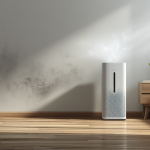A healthy home needs clean air. However, mold can harm our air quality. It can even lead to severe health problems. In this simple guide, we’ll look at ways to test for mold in your home’s air. This includes signs of mold and DIY testing methods. We’ll also cover how to hire a professional.
Knowing how to test for mold is valuable knowledge. It helps you to understand and react to results. This allows homeowners to handle mold problems. As a result, you can keep your home’s air quality high.
Spotting Mold Contamination
Knowing early signs of mold can keep your health and home safe. Do you smell a damp or musty odor? That could be a sign of hidden mold. Do you see black, green, or white spots or streaks? That’s a clear sign of mold. If you or anyone at home experience allergies, coughs, or skin irritation, it could be due to mold. Mold can grow in places where there are water leaks or damage. It is also common in bathrooms where there is high humidity or condensation. If your paint begins to peel or crack because of mold underneath it, that is another sign.
If you live in humid areas or see your house having more moisture, mold could be lurking around. Mold may cause discoloration on surfaces or fabrics. It can also warp wood or cause damage to your house structure. If your home was previously flooded, it’s likely mold got a chance to develop.
Detecting and Preventing Hidden Mold
Please note, while identifying early signs of mold is crucial, it’s equally essential to understand that not all molds are visually detectable. Some mold may lurk in air ducts, behind wallpapers, or under carpets, making early detection challenging. Therefore, regular home inspections and maintaining low indoor humidity levels are key preventive measures. If you suspect mold growth, consulting with professional mold remediation experts is advisable for a thorough inspection and proper removal. Ensuring your living environment is safe from mold not only protects your health but also preserves the integrity of your property. Stay vigilant and proactive in mold prevention.

DIY Methods
Looking to understand your air quality? Start with an air quality monitor. They’re excellent at finding pollutants. This includes mold spores. They do this by checking the amounts of PM2.5, CO2, VOCs, along with temperature and humidity. Models such as the “Dylos DC1100 Pro Air Quality Monitor” or the “Temtop M2000C Air Quality Monitor” are great for this.
Next, think about using petri dishes with something like malt extract or Sabouraud dextrose. It helps grow mold. Simply expose these dishes to your home’s air. After that, close them and wait 1-2 days. Check for mold growth. To go deeper, use home testing kits. The “Mold Inspection Network DIY Mold Test” or the “Healthful Home 5-Minute Mold Test” aim to do this.
Also, check out the Zefon Bio-Pump Plus. It’s an air sampling pump. Though a lab needs to evaluate the samples, the results are valuable.
Another method is the Environmental Relative Mouldiness Index (ERMI). It’s a DNA-based mold detection system. It used to be for pros only. However, DIY kits are now available. They show you the types and quantity of mold in your home.
The Biod Tape Method and DIY bulk sampling are other ways. You use clear tape to collect the samples. A microscope is then used to check for mold types and spore counts. DIY bulk sampling uses a small material sample sent to a lab for full analysis.
Always remember to interpret test results right. You might need a professional’s advice. Also, DIY tests may vary in reliability. It’s better to get a pro for serious mold problems.undefinedKeep checking different locations in your home regularly. Also, handle any moisture issues. It will prevent future mold occurrence. Regular cleaning, controlling humidity, and increasing ventilation are preventive steps for healthy indoor air.
Professional Air Quality Testing
Improve the health of your home with Pro Air Quality Testing Services. The experts here are highly skilled in different techniques. They look for out-in-the-open and hidden mold in your house. Top-grade tools like infrared imaging and air testing tools are their go-to. They leave no stone unturned.
Air testing is a key part of their service. It uses two special methods to track down all molds. This gives you a full view of your home’s air quality. After that, the samples ship out to top labs. Here, experienced people determine the mold type and how much is there. The outcome is an in-depth report highlighting problem spots. It also gives an action plan to fix them.
These services have the future in mind. They not only identify the mold but also offer prevention tips. Plus, they help you interpret the results. You’ll receive solid advice on the necessary steps and how to maintain good air quality over time.
With frequent use of pro air quality testing, you’re defending your home from unseen threats. This guarantees a safer, healthier living space. These services blend science and dedication to provide more than just results, but a roadmap to keep your house mold-free.

Mold Test Results
When you test your home’s air quality for mold, it’s important to look at the results carefully. First, look at how many mold spores were found in your space. If there are more than a thousand, this could be a problem. Equally, if you find types of mold indoors that aren’t found outdoors, this could also indicate an issue.
Next, look at which specific types of molds were found. Some of these, like black mold, can lead to serious health issues. Mold or dampness that you can see might mean that there are hidden problems.
Understanding the different types of mold is very important. Having a lot of a type of mold that spreads quickly might not be as big of a problem as having a smaller amount of a mold that’s difficult to get rid of. Also, being exposed to many types of mold at once could increase health risks.
Your own health situation should influence how you interpret the test results. Some people are more sensitive to mold than others, and some may have health conditions that make mold exposure riskier. The method used for the mold test, either air or surface sampling, can also make a difference in your interpretation.
Mold levels can change depending on the time of year. If indoor levels go up when outdoor levels are low, it’s a red flag. So, it’s better to do several tests over time, rather than a single one.
Lastly, because mold analysis can be complicated, it’s a good idea to consult with a professional. They can guide you on what steps to take next.
In short, understanding your mold test results is like putting together a puzzle. The numbers are just part of the story. Understanding their meaning can help guide you toward a healthier home.
Taking Action on Test Results
Got mold test results for your house? Now’s the time to act. The first step is knowing what the results mean. If you’ve got normal spore counts, your air quality is good. No problem there. But if there’s a rise in spores, be it small or large, it’s time to get busy.
For small increases, look for places where water might build up. Then, make some fixes to bring down the humidity. But if there’s a lot of spores, call a pro. They have the know-how, the gear, and the safety actions to deal with mold and track down the water issue.
Got a tiny bit of mold? Cleaning it yourself with mild soap might be enough. But you might need to toss things like carpets. Stopping mold in the future means managing moisture. Fix leaks quickly, use dehumidifiers, make your ventilation better, and dry damp spots fast.
After the mold is gone, re-test your house to see if you got it all. If there’s a risk for your health, you might need to stay somewhere else while the cleanup happens. If you’re unsure about tackling mold, talk to a pro. That way, you keep your house and you safe.
Breathe Cleaner
Make sure you keep your air clean and safe with our CADR320 Home Air Purifier. This innovative product from Hoko achieves a remarkable 99.97% effectiveness in removing bacteria, ensuring that your air remains clean and protected from hazardous contaminants. It’s time to breathe easy and enjoy a healthier home environment. You’ve already taken the first step by tackling mold. Now, take the next step with us.

Keeping Your Air Clean with an Air Purifier
Keeping your air clean is key for good health. Here are some steps to make it happen:
- Clean Regularly: Clean often. This includes vacuuming twice a week with a HEPA filter vacuum to cut down on dust and pet dander.
- Check Ventilation: Change filters regularly to keep your air fresh.
- Control Moisture: Keep your humidity between 30-50% with dehumidifiers or ACs. This stops mold and mite growth. Fix leaks quickly and use mold-resistant materials in damp places.
- Smoke-Free: No smoking inside. This helps keep your air clean.
- Air Cleaners: Use air purifiers to cut down allergens. When picking furniture and paint, choose items that are mold resistant.
- Indoor Plants: Some indoor plants can help clean your air.
- Cut Down on Chemicals: Use fewer aerosol products. Choose cleaning and decorating products with low or no VOCs.
- Fend off Allergens: Wash your fabrics in hot water and use allergen-proof covers.
With these steps, you can make a clean, healthy space for everyone in your home.
Conclusion
Clean air is important for health, and dealing with mold is a key part of that. Air purifiers help deal with mold and other air nasties, making your indoor air cleaner and healthier. Additionally, regular cleaning, moisture management, and good ventilation boost your indoor air quality and promote better health. Take the right steps and use air purifiers to create a cleaner, healthier space for a better lifestyle.


